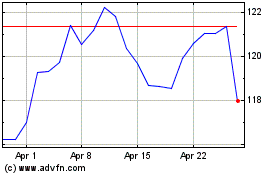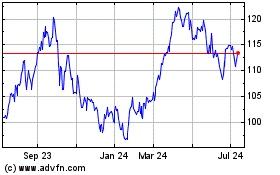By Sarah Kent and Bradley Olson
The world's biggest oil companies are getting thrifty.
Oil prices have made a modest comeback from the lows hit a
little over a year ago, but energy companies such as Exxon Mobil
Corp. and BP PLC aren't pursuing the extravagant bets they made at
$100 a barrel -- like commissioning multibillion-dollar projects in
Arctic waters and Kazakhstan's Caspian Sea.
These companies, including Exxon, BP, Royal Dutch Shell PLC and
Chevron Corp., are putting their money into cheaper, quicker
ventures in Texas shale country, the Middle East and Brazil and
squeezing more from existing projects world-wide.
Exxon last week unveiled an ambitious plan to put its U.S.
drilling opportunities in Texas, New Mexico and North Dakota at the
heart of its future. By 2025, the company said, its production from
these areas could more than triple to the equivalent of 750,000
barrels a day. Together with other shale production, that would
amount to about a third of Exxon's current output.
It is a shift away from the business model long-employed by the
world's largest oil companies, favoring technologically challenging
projects that had huge upfront costs that would be paid off over 20
or 30 years.
To drive down costs, big oil companies are abandoning such
developments in favor of standardization and bolt-on models that
take advantage of existing infrastructure. They are returning to
old basins to see what they can extract with new technologies and
focusing on the lowest-cost prospects.
The appeal of cheaper projects that can bring oil or gas to
market within a few years is that it allows big companies to avoid
being locked in to multibillion investments over as much as a
decade, said Ryan Lance, the chief executive of ConocoPhillips, at
the annual CERAWeek conference in Houston on Tuesday.
"They're not just paying lip service to this," said Luke Parker,
vice president of corporate analysis at Wood Mackenzie, a Scottish
energy consultancy. "They want to be in a position to future proof
themselves against peak oil demand when it comes."
The challenge of the strategy is that many of the big Western
companies have yet to prove that they can consistently turn a
profit in a time of lower prices, especially in U.S. shale fields.
Increasing production may prove even more daunting since the
companies have to spend billions just to replace the barrels they
pump every year.
Last week, BP announced plans to drive down its break-even oil
price to between $35 and $40 a barrel by 2021, all while increasing
production. It is a feat the British oil giant says it can pull off
by maintaining strict cash discipline, driving down costs and
focusing on projects that generate strong returns even at current
prices.
BP recently abandoned ambitious plans to explore in the Great
Australian Bight -- a potentially huge source of new supply that
still couldn't compete economically with other project
opportunities. Instead, it invested $2 billion for a 10% stake in
oil fields in the United Arab Emirates, which has some of the
world's lowest oil-extraction costs.
Going forward, the company is focusing on "long-lived cash
bricks" of low cost oil and natural gas, said BP Chief Executive
Bob Dudley during an interview at CERAWeek.
Others are pursuing a similar agenda. Chevron CEO John Watson
told analysts Tuesday that the company intends to invest more of
its capital budget in projects that start up quickly and generate
higher returns. About three-fourths of the company's $20 billion
capital budget in 2017 will generate cash within two years, Mr.
Watson said.
Shell is focusing the bulk of its new investment on deep water
projects offshore Brazil that it says break even at less than $40 a
barrel. France's Total SA says reducing the break-even level on its
projects is "a top priority." Last week, Italy's Eni SpA said new
projects out to 2020 will have an average break-even of $30 a
barrel.
The focus on frugality is a departure from the 10-year period
from 2005 to 2014, when concerns that supply could run out and
soaring oil prices sent energy companies on a grand, often wildly
expensive, chase for new production.
They took on projects like Kashagan, a giant oil field in
Kazakhstan that took Exxon, Shell and others over a decade and $50
billion to develop. It will produce oil for decades but has become
a cautionary tale, especially after oil prices began falling in
2014.
According to Sanford C. Bernstein, Europe's biggest oil
companies have slashed capital budgets by $51 billion since their
2013 peak and are expected to keep spending at current levels of
around $90 billion a year through to 2020, but production volumes
are on the rise.
A similar pattern also is emerging at Exxon and Chevron, both of
which have roughly halved spending since 2013, but production is
still seen increasing, according to estimates from S&P Global
Market Intelligence.
Fatih Birol, executive director of the International Energy
Agency in Paris, warned Monday that shorter cycle investment plans
could create an oil price shock. The IEA estimates oil and gas
investment dropped to $450 billion annually during the two-year
energy downturn, 25% less than it needs to be to meet future global
demand growth and offset declines in existing fields.
Mr. Birol said investments globally need to rise at least 20% to
avoid oil price spikes in the coming years.
Another challenge for these companies will be to prove that they
can pivot successfully.
Even as Exxon plans to boost its U.S. focus -- including with a
$20 billion spending plan on American refinery and processing
operations -- the company lost $4.2 billion in its American
oil-and-gas drilling business last year and more than $500 million
in 2015. While many of the companies are moving ahead with
investments on what now appear to be profitable projects from South
America to Papua New Guinea, they face a major risk of surging
costs that would erode returns.
"Our job is to compete and succeed in any market, irrespective
of conditions or price," said Exxon's new CEO Darren Woods last
week.
Write to Sarah Kent at sarah.kent@wsj.com and Bradley Olson at
Bradley.Olson@wsj.com
(END) Dow Jones Newswires
March 08, 2017 07:14 ET (12:14 GMT)
Copyright (c) 2017 Dow Jones & Company, Inc.
Exxon Mobil (NYSE:XOM)
Historical Stock Chart
From Mar 2024 to Apr 2024

Exxon Mobil (NYSE:XOM)
Historical Stock Chart
From Apr 2023 to Apr 2024
